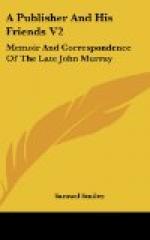Mr. Murray therefore put himself into communication with Lord Byron’s nearest friends and relations with respect to the disposal of the Memoirs. His suggestion was at first strongly opposed by some of them; but he urged his objections to publication with increased zeal, even renouncing every claim to indemnification for what he had paid to Mr. Moore. A meeting of those who were entitled to act in the matter was at length agreed upon, and took place in Murray’s drawing-room, on May 17, 1824. There were present Mr. Murray, Mr. Moore, Mr. J.C. Hobhouse, Colonel Doyle representing Lady Byron, Mr. Wilmot Horton representing Mrs. Leigh, and Mr. Luttrell, a friend of Moore’s. Young Mr. Murray—then sixteen; the only person of those assembled now living [1891]—was also in the room. The discussion was long and stormy before the meeting broke up, and nearly led to a challenge between Moore and Hobhouse. A reference to the agreement between Moore and Murray became necessary, but for a long time that document could not be found; it was at length discovered, but only after the decision to commit the manuscript to the flames had been made and carried out, and the party remained until the last sheet of Lord Byron’s Memoirs had vanished in smoke up the Albemarle Street chimney.
Immediately after the burning, Mrs. Leigh wrote the following account to her friend, the Rev. Mr. Hodgson, an old friend of Byron’s:
The Hon. Mrs. Leigh to the Rev. f. Hodgson.
“The parties, Messrs. Moore, Murray, Hobhouse, Col. Doyle for Lady B., and Mr. Wilmot for me, and Mr. Luttrell, a friend of Mr. Moore’s, met at Mr. Murray’s; and after a long dispute and nearly quarrelling, upon Mr. Wilmot stating what was my wish and opinion, the MS. was burnt, and Moore paid Murray the 2,000 guineas. Immediately almost after this was done, the legal agreement between Moore and Murray (which had been mislaid), was found, and, strange to say, it appeared from it (what both had forgotten), that the property of the MS. was Murray’s bond fide. Consequently he had the right to dispose of it as he pleased; and as he had behaved most handsomely upon the occasion ... it was desired by our family that he should receive the 2,000 guineas back.” [Footnote: “Memoir of the Rev. F. Hodgson,” ii. 139-40.]
But the Byrons did not repay the money. Mr. Moore would not permit it. He had borrowed the 2,000 guineas from the Messrs. Longman, and before he left the room, he repaid to Mr. Murray the sum he had received for the Memoirs, together with the interest during the time that the purchase-money had remained in his possession.




